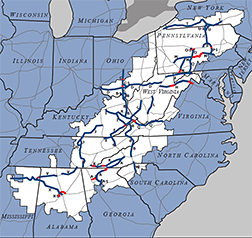Appalachian Development Highway System
Congress created the Appalachian Development Highway System (ADHS) expressly to provide growth opportunities for the residents of Appalachia—the same benefits afforded the rest of the nation through the construction of the interstate highway system, which largely bypassed Appalachia because of the high cost of building roads through the Region's mountainous terrain. The ADHS, a 3,090-mile system of modern highway corridors will generate economic development in previously isolated areas, supplement the interstate system, and provide access to areas within the Region as well as to markets in the rest of the nation and overseas.
As of FY 2019, 2,805.6 miles, or 90.8 percent, of the ADHS is under construction or open to traffic. Read the latest ADHS status report.
According to Economic Analysis of Completing the Appalachian Development Highway System, published by ARC in 2017:
- Increased economic activity associated with the ADHS system has helped create or support more than 168,000 jobs across the 13 Appalachian states, with nearly $7.3 billion of added worker income annually;
- ADHS investments made between 1965 and 2015 generated more than $19.6 billion per year of added business sales in Appalachia, representing over $9 billion of added gross regional product;
- The ADHS saves 231 million hours of travel time annually. Twenty percent of car vehicle hours saved and 31 percent of freight truck vehicle hours saved are associated with trips with at least one end located outside the Appalachian states;
- As of 2015, the value of transportation cost savings and productivity gains associated with the ADHS amounts to $10.7 billion annually.
- Completion of the ADHS is estimated to create nearly 47,000 more jobs and facilitate the production and selling of $8.7 billion more in goods and services annually across the 13 Appalachian states.
|

